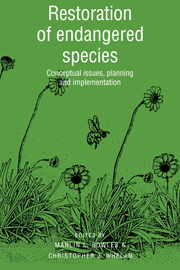Book contents
- Frontmatter
- Contents
- List of contributors
- Foreword
- Acknowledgments
- I Conceptual issues in restoration ecology
- II Restoration planning
- 6 Impacts of biological invasions on the management and recovery of rare plants in Haleakala National Park, Maui, Hawaii
- 7 Disturbance-dependent persistence of rare plants: anthropogenic impacts and restoration implications
- 8 A metapopulation approach to Pitcher's thistle (Cirsium pitcheri) recovery in southern Lake Michigan dunes
- 9 Restoration of woodland caribou to the Lake Superior region
- III Implemented restorations
- IV Synthesis and future directions: biology, politics and reality
- Taxonomic Index
- Subject Index
7 - Disturbance-dependent persistence of rare plants: anthropogenic impacts and restoration implications
Published online by Cambridge University Press: 27 January 2010
- Frontmatter
- Contents
- List of contributors
- Foreword
- Acknowledgments
- I Conceptual issues in restoration ecology
- II Restoration planning
- 6 Impacts of biological invasions on the management and recovery of rare plants in Haleakala National Park, Maui, Hawaii
- 7 Disturbance-dependent persistence of rare plants: anthropogenic impacts and restoration implications
- 8 A metapopulation approach to Pitcher's thistle (Cirsium pitcheri) recovery in southern Lake Michigan dunes
- 9 Restoration of woodland caribou to the Lake Superior region
- III Implemented restorations
- IV Synthesis and future directions: biology, politics and reality
- Taxonomic Index
- Subject Index
Summary
Introduction
Plants have evolved in heterogeneous environments under a variety of abiotic and biotic disturbances that vary in gradients of frequency, intensity, extent, and predictability across and within communities (White 1979, Pickett & White 1985). As a result, most plant species are adapted to disturbance at some scale for their regeneration (Platt 1975, 1976, Grubb 1977, Huntly & Inouye 1988, Klinkhamer & De Jong 1988), and persist in space and time through differential sensitivity of life stages, seed dispersal mechanisms, seed dormancy strategies, or modes of vegetative growth (Brown & Venable 1986, Silvertown 1987, Caswell 1990).
For rare plants with specialized adaptations to natural disturbance regimes, variation in the scale of disturbance can be critical in determining their population viability (Menges 1991a) and restoration needs. The effects of disturbance on these plants can be viewed according to their realized niche spaces, which are maintained by the natural disturbance regimes. Novel disturbances that mimic natural disturbance regimes may expand or replace realized niche space, allowing the species to persist or even increase in population size. In contrast, novel disturbances that do not mimic natural disturbances could eliminate realized niche space, thus threatening the viability of the plant species in question. Thus, many species have been extirpated or reduced in abundance (Hodgson 1991, Schoener 1987), while others (e.g. ragweed) have experienced new or expanded ecological and evolutionary opportunities (Marks 1983).
Humans can impact the niche space of disturbance-adapted rare plants directly or indirectly (Rykiel 1985, Grime 1979, Pickett & White 1985, Petraitis, Latham & Niesenbaum 1989, Bowles et al. 1992).
- Type
- Chapter
- Information
- Restoration of Endangered SpeciesConceptual Issues, Planning and Implementation, pp. 159 - 193Publisher: Cambridge University PressPrint publication year: 1994
- 23
- Cited by



